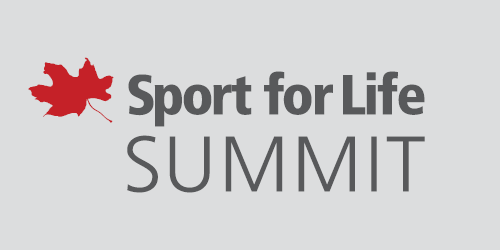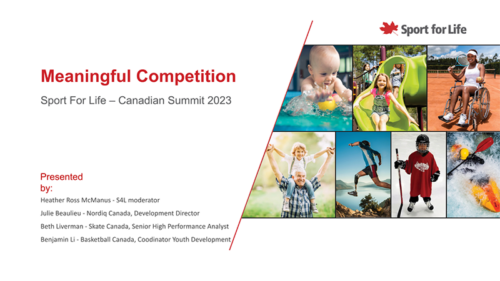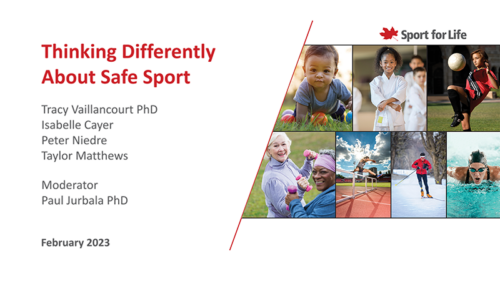 The first of our 2023 Sport for Life Summits took place in Ottawa on February 8 and 9.
The first of our 2023 Sport for Life Summits took place in Ottawa on February 8 and 9.
The Ottawa Summit organizers prioritized knowledge exchange and engagement at the core of the program design, and it was an ideal opportunity for NSOs, MSOs, researchers, coaches, athletes and administrators to sit down and discuss big picture topics surrounding the sport system in Canada.
A report on the many Summits being held across Canada will follow after they conclude.
Leading Culture Change
Culture change has been a significant topic of conversation in the Canadian sport sector for several years, and for good reason. The culture of a sport system, environment or program plays a key role in the level of safety, inclusion and enjoyment that participants experience. But what does it mean to lead culture change, and how can culture add meaning to participant’s sport experiences? To answer these questions, this session featured four dynamic presenters.
First, Dr. Bettina Callary, an associate professor at Cape Breton University, presented alongside Indigenous collaborator Levi Denny, the Mi’kmaw sports performance coordinator at Mi’kmaw Kina’matnewey, a Nova Scotia-based Mi’kmaw advocacy group. Their presentation explored the broad connections to nature and Indigenous culture that have shaped the experience of youth enrolled in a Cape Breton-based surf program, highlighting the need to support equity, diversity, inclusion, and Indigenization through alternative programming perspectives.
Next, Richard Sylvester, a Long-Term Development Advisor, strength and conditioning specialist, and PhD candidate, told engaging stories about his experiences building team culture with athletes from different countries, sports, ages and ethnic cultures. He emphasized the importance of building safety, trust and connection through simple activities and gestures, and communicating effectively with participants and parents.
Finally, Dr. Eric MacIntosh, a University of Ottawa sport management professor, concluded the session with a compelling presentation about his research on athletes’ perceptions of safe and unsafe environments in high performance sport. He addressed the importance of understanding the values that help make sport safe, and drew attention to the disconnect between the values that organization’s claim to espouse, and what actually happens in practice.
 Meaningful Competition
Meaningful Competition
Heather Ross-McManus kicked off this session with a review of what we mean by Meaningful Competition and why it is important for the long-term development of athletes, as “competition contributes to positive development of all athletes”. When competition is developmentally appropriate, it is aligned with the sport’s athlete development matrix and the competition structure is reinforced and tests the skills that are important. Competitors stay in the “challenge zone” most of the time.
National sport organizations continue to modify their competition structures and calendar to use competition as part of the development process. Nordiq Canada’s Jacqueline Beaulieu, Skate Canada’s Beth Liverman and Canada Basketball’s Benjamin Li shared the modifications to competition structures being undertaken in their organizations and their next priorities in implementing these changes.
Inclusive Sport
After a brief overview of the history of exclusion in sport by the moderator, Colin Higgs, the session consisted of three separate presentations, each looking at different aspects of inclusion in sport.
The first presentation looked at wheelchair curling from the perspective of both beginners/recreational curling and from the perspective of preparing high-performance athletes for excellence. Elaine Brimicombe and Kerrie Whitehurst described their challenges in setting up a recreational wheelchair curling program in a curling club that supported their efforts, and Tiago Duarte echoed many of the same accessibility and stigma issues, while expanding on the difficulties of finding appropriate competitive opportunities for those athletes trying to reach the top. With international play requiring at least one female curler per team, the dearth of female curlers was identified as a performance barrier.
The focus changed completely when Sara Kramers described her very intense work helping a single coach explore her attitudes and beliefs around inclusion of athletes with different sexualities. By probing assumptions, posing difficult questions, and encouraging critical reflection, Sara described how attitudes and coaching practices can evolve to better meet the needs of athletes and improve their sporting experience.
The third presentation looked at the experiences of athletes who entered inclusion-focused sport programs and faced difficulties transitioning to more mainstream sport. Kim Gurtler spoke about the ringette program for athletes with any abilities that she and her daughter started, and how using athletes from a mainstream program as volunteers helped some athletes move to programs that matched their increasingly skilful play. Carolyn Trono ended the session with a discussion of the barriers – including transportation, program fees, and time commitment – faced by refugee and immigrant youth from a newcomers sport program when they tried to make the transition to more competitive sport.
 Thinking Differently About Safe Sport
Thinking Differently About Safe Sport
While high-profile cases of maltreatment of national team athletes have been making the news, it’s important to remember that most sport happens in the community. The most-reported forms of maltreatment are psychological, such as harassment, bullying and neglect, including peer to peer maltreatment. Initiatives such as the Universal Code of Conduct to Prevent and Address Maltreatment in Sport are valuable but they may not reach down to where most sport is played.
To make sport safer and keep more participants in sport we need to think differently about how to prevent maltreatment in sport. Session presenters included Tracy Vaillancourt, PhD, University of Ottawa. She explored the neurobiology of interpersonal relationships in the context of youth sports, with links to mental health and performance. Isabelle Cayer, Director of Sport Safety, Coaching Association of Canada presented on Moving Safe Sport forward in coaching. Taylor Matthews, project manager for the Ottawa Sport Council shared the Ottawa Safe Sport Toolkit.
Some key insights from the presentations were (1) harassment, bullying and neglect cause long-term physical and mental harm, and the neuro-physiological effects actually depress athlete learning and performance and likely contribute to drop-out; (2) coaches can play a bigger role in understanding and supporting positive interpersonal relationships in sport and reducing some common psychological abuses, including peer-to-peer bullying; (3) community sport organizations should be challenged to review and revise their practices even when supports such as the Ottawa Safe Sport Toolkit are provided, as more help in the form of template policies and in-community mentoring may be essential to making sport safer at the local level.
